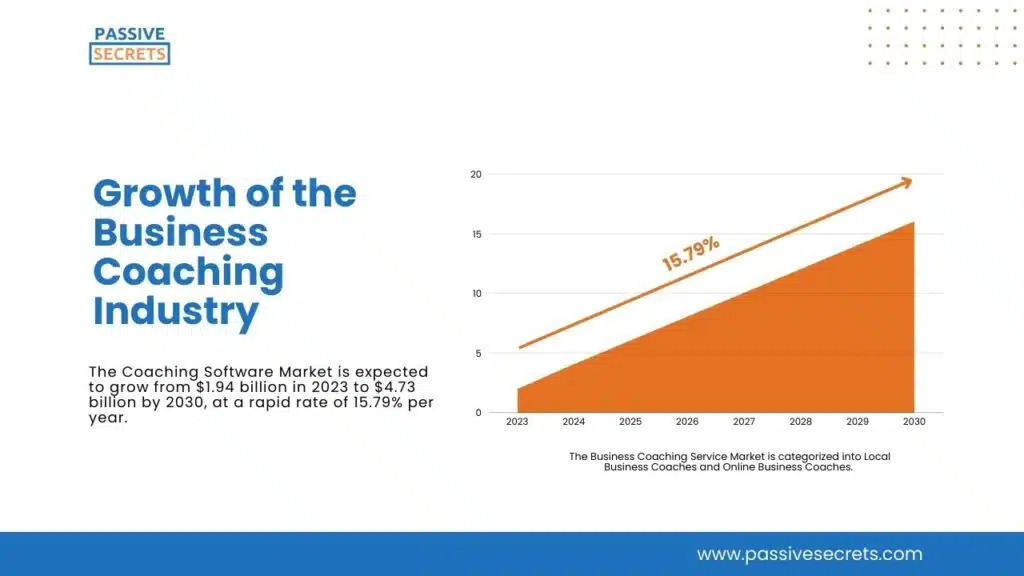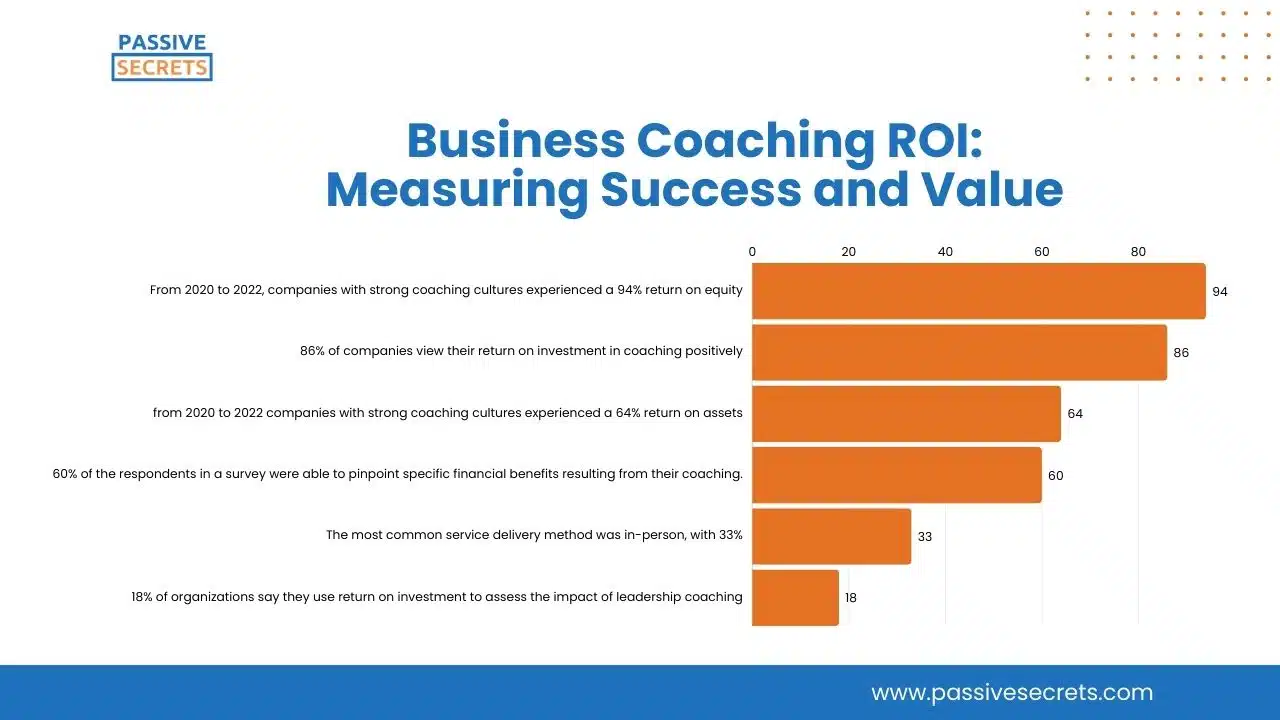
Business coaching has become a powerful tool for companies aiming to boost employee performance, strengthen leadership, and foster a thriving workplace culture.
In recent years, the demand for business coaching has increased, with companies of all sizes investing in coaching programs to achieve measurable results and increase their competitive edge.
Statistics show that business coaching not only enhances productivity and employee engagement but also delivers a substantial return on investment (ROI).
This article reveals the latest business coaching statistics, offering valuable insights into how coaching impacts organizations, popular coaching areas, and the future of this fast-growing industry.
Key Business Coaching Statistics (Editor’s Pick)
- Executive coaching accounts for approximately 36% of the total coaching market.
- 67% of business coaches are women.
- 38% of coaches use multiple platforms and apps.
- The executive coaching certification market was valued at $10.3 billion in 2023 and is expected to grow to $31.9 billion by 2034, expanding at a compound annual growth rate (CAGR) of 10.8% from 2024 to 2034.
- The number of U.S. Business Coaching businesses in 2023 has grown to 77,118, representing a 5.3% increase from the previous year.
- 86% of companies view their return on investment in coaching positively.
- 18% of organizations say they use return on investment to assess the impact of leadership coaching.
- 72% of organizations provide some form of leadership coaching for talent development.
- 60% of organizations provide coaching for leadership development.
- 65% of employees believe that coaching from their manager is crucial for their performance and career development.
- Companies with a strong coaching culture experience a 21% increase in team innovation compared to their counterparts.
- 59% of surveyed respondents stated that budget is a challenge to providing leadership coaching.
General Business Coaching Statistics
1. Male coaching practitioners are more inclined to specialize in business, with 74% having this focus compared to 61% of female coaching practitioners. (source)
2. Executive coaching accounts for approximately 36% of the total coaching market. (source)
3. The most prevalent coaching specialization is business/executive coaching, which makes up 62%. (source)
4. 67% of business coaches are women. (source)
5. The average age of business coaches ranges from 45 to 55 years. (source)
6. 67% of business coaches hold a postgraduate degree. (source)
7. The typical business coach has 12 years of experience in their field prior to becoming a coach. (source)
8. The majority of managers and leaders who utilize coaching skills (61%) hold a postgraduate degree (master’s or doctoral), while one in three (34%) have completed secondary education (bachelor’s degree). (source)
9. 38% of coaches use multiple platforms and apps. (source)
10. The top three states with the highest number of Business Coaching businesses in the US are:

11. 23% of surveyed respondents anticipated a significant rise in demand for executive coaching, while 45% expected only a slight increase. (source)
Growth of the Business Coaching Industry
12. In the US, the revenue from business coaching has decreased at a compound annual growth rate (CAGR) of 0.3% over the last five years, reaching an estimated $14.1 billion in 2024. (source)
13. Among coaching practitioners who specialize in business, 40% of their engagements usually last seven months or longer, whereas only 28% of those with a non-business specialty have engagements of that duration. (source)
14. Compared to 2015, the percentage of coaching practitioners who consider Business Coaching their primary specialty rose by three percentage points, increasing from 62% in 2016 to 65% in 2019. (source)
15. About 58% of coaches spend at least 2 hrs per week on administrative tasks whereas about 28% spend at least 5 hrs per week. (source)
16. The executive coaching certification market was valued at $10.3 billion in 2023 and is expected to grow to $31.9 billion by 2034, expanding at a compound annual growth rate (CAGR) of 10.8% from 2024 to 2034. (source)
17. The market for Executive Coaching and Leadership Development is projected to grow from $94.8 billion in 2024 to $147.5 billion by 2029, at a rate of 9.24% per year. (source)
18. The global Business Coaching Service Market is expected to grow from $1.32 billion in 2023 to $2.57 billion by 2032, at a rate of 7.6% per year. (source)
The Business Coaching Service Market is categorized into Local Business Coaches and Online Business Coaches.
19. The Coaching Software Market is expected to grow from $1.94 billion in 2023 to $4.73 billion by 2030, at a rapid rate of 15.79% per year. (source)

20. As of 2023, the number of Business Coaching businesses in the US has grown to 77,118, representing a 5.3% increase from the previous year (2022). (source)
Impact of Business Coaching on Employee Performance
21. When training is paired with coaching, individuals boost their productivity by an average of 86%, whereas training on its own leads to only a 22% increase. (source)
22. Eric Schmidt believes that Google and Apple owe a considerable portion of their trillion-dollar valuations to their business coach, Bill Campbell. (source)
23. There’s a 15% improvement in crisis-handling skills in companies with strong coaching versus those lacking it. (source)
24. 72% of employees who use business coaching use habit trackers (& check them weekly) while 44% do not utilize habit trackers. (source)
Business Coaching ROI: Measuring Success and Value
25. 86% of companies view their return on investment in coaching positively, indicating that the investment at least covered its costs. (source)

26. From 2020 to 2022, companies with strong coaching cultures experienced a 94% return on equity and a 64% return on assets, in contrast to their peers with low or no coaching culture. (source)
27. The most common service delivery method was in-person, with 33% of surveyed respondents reporting that they offered executive coaching face-to-face. (source)
28. Coaching yielded a 529% return on investment, along with considerable intangible benefits for the business. When factoring in the financial benefits from employee retention, the overall ROI increased to 788%. (source)
29. 60% of the respondents in a survey were able to pinpoint specific financial benefits resulting from their coaching. (source)
30. 18% of organizations say they use return on investment to assess the impact of leadership coaching. (source)
31. Individual self-evaluation (52%) and employee involvement (48%) were the two most frequently used metrics for assessing the effects of leadership coaching. (source)
Business Coaching and Leadership Development
32. 72% of organizations provide some form of leadership coaching for talent development. Additionally, almost a quarter (22.5%) of respondents expressed that they do not currently offer leadership coaching but would like to. (source)
33. Among organizations that offer leadership coaching, 28% provide formal internal coaching, 19% offer informal internal coaching, and 24% use external partners for coaching. (source)
34. 60% of organizations provide coaching for leadership development. (source)
35. Most organizations, 67%, employ both internal and external coaches for leadership development. (source)
36. Among managers and leaders who use coaching skills and reported having received coach-specific training, 78% indicated they completed 60 or more hours of such training. (source)
37. The ratio of leadership development professionals to managers also decreased by 70%. (source)
Employee Demand and Attitudes Toward Coaching
38. 18% of employees facing uncertainty are more likely to believe that they can achieve significant change with the help of a coach. (source)
39. Employees dealing with uncertainty are more optimistic due to the impact of coaching. (source)
40. 65% of employees believe that coaching from their manager is crucial for their performance and career development. (source)

Business Coaching and Company Culture
41. Companies with a strong coaching culture see a 14% boost in problem-solving capabilities compared to those without. (source)
42. Strong coaching cultures enhance team agility by 18% compared to teams without this support. (source)
43. Companies with a strong coaching culture experience a 21% increase in team innovation compared to their counterparts. (source)
44. A strong coaching culture results in a 32% enhancement in strategic planning compared to companies without it. (source)
45. A strong coaching culture enhances job satisfaction by 39% and organizational commitment by 22%. (source)
Challenges in Measuring Business Coaching Success
46. Among the 72% of companies that provide leadership coaching, budget constraints are noted as the most common challenge, followed by difficulties in measuring ROI. (source)
47. 59% of surveyed respondents stated that budget is a challenge to providing leadership coaching. (source)
48. Top expenses in the US Business Coaching industry:

Trends in Business Coaching
1. Virtual Coaching
Virtual coaching has quickly become a leading trend in business coaching, transforming how services are delivered.
This shift was initially driven by technological advances and also the impact of the COVID-19 pandemic.
It currently offers so many benefits to business coaches which include; Coaches can connect with clients from anywhere using platforms like Zoom and Skype, making sessions more flexible and convenient.
It helps to eliminate additional costs associated with business coaching in physical office spaces. This accessibility allows more people to benefit from coaching services.
The demand for virtual coaching is expected to grow due to the increased recognition for the value of coaching.
2. Artificial Intelligence in Coaching
Artificial intelligence (AI) is quickly becoming a major trend in business coaching, changing how coaching is done. AI tools help coaches provide better support by offering real-time insights into a client’s progress and giving personalized advice. This makes coaching more effective and efficient.
AI can also match clients with the right coaches based on their specific needs and goals. Additionally, it can analyze how clients speak and express emotions during coaching sessions which ensures a more tailored experience.
Moreover, AI makes coaching more accessible to a wider range of people by lowering costs and improving technology.
As AI continues to grow in the coaching field, it will lead to new ways for coaches and clients to connect and work together effectively.
3. Group Coaching for Greater Accountability
Group coaching is becoming a popular trend in business coaching, especially for enhancing accountability among employees.
In a company setting, this approach involves bringing together a small group of individuals who share similar goals or challenges. By working together, they can learn from each other and provide support.
During group coaching sessions, participants discuss their experiences, set personal goals, and regularly check in on their progress.
This structure encourages everyone to take responsibility for their commitments, knowing they will report back to the group. The peer support helps motivate individuals to stay on track and overcome obstacles.
Group coaching would help to foster teamwork and build stronger relationships within the organization.
By implementing group coaching, companies can create a culture of accountability and continuous improvement, leading to better performance and engagement among their teams.
Conclusion
The data on business coaching shows a clear trend: investing in coaching yields measurable benefits for both individuals and organizations.
With proven gains in productivity, leadership skills, and employee satisfaction, it’s no surprise that business coaching continues to grow in popularity across industries.
As companies increasingly recognize the value of coaching, this trend is expected to expand, bringing even more focus on specialized areas such as executive leadership, team cohesion, and personal development.
By staying informed about the latest coaching statistics and trends, businesses can leverage these insights to build stronger, more resilient teams and foster an adaptable, high-performing culture for years to come.
FAQs

Other Related Statistics You Should Know:
- Incredible Women in Leadership Statistics: Insights into Global Gender Representation
- Billionaire Statistics: Surprising Insights About The World’s Wealthiest
- 89 Business Loan Statistics Every Entrepreneur Should Know
- 70+ AI in Education Statistics That Prove the Future Is Already Here
- Soft Skills Statistics: Key Data on Demand, Training, and Impact
- 95+ Fascinating Gift Industry Statistics to Surprise and Delight
- How Much Are People Saving? Key Personal Savings Statistics Explained
- 40+ Useful Procrastination Statistics To Help You
- 90 Amazing Millionaire Statistics & Facts You Dare Not Miss
- 50+ Latest Life Coaching Statistics And Huge Trends
- 30+ Useful Real Estate Photography Statistics and Trends You Need to Know
- Data-Driven Decision-Making Statistics: Trends, Benefits & Challenges
- 54 Incredible Goal-Setting Statistics To Help You
- 45+ Interesting Communication Skills Statistics & Huge Trends
- Body Language Statistics & Fun Facts To Boost Your Communication Skills
- 35 Interesting Public Speaking Fear Statistics & Fun Facts
- 25+ Most Interesting Emotional Intelligence Statistics & Fun Facts

